Gap Analysis of Priority Medicinal Plant Species in the Kingdom of Saudi Arabia
Abstract
1. Introduction
2. Results
2.1. Overview of Data and Distribution of Medicinal Plants in the Kingdom of Saudi Arabia
2.2. Ecogeographic Land Characterization
2.3. In Situ Gap Analysis
2.4. Complementarity Analysis
2.5. Ex Situ Gap Analysis
3. Discussion
4. Materials and Methods
4.1. Species Selection
4.2. Occurrence and Diversity of Medicinal Plant Species
- (a)
- Fieldwork (March–August 2024): Field surveys were conducted by the first author in regions identified as medicinal plant hotspots based on herbarium records and relevant literature [16,18,44]. Sites were selected using historical records indicating the presence of priority medicinal plant species. During each site visit, populations of medicinal plants were recorded using handheld GPS devices.
- (b)
- Herbarium records: Data were compiled from the Royal Botanic Gardens, Kew, and the Royal Botanic Garden, Edinburgh (https://data.rbge.org.uk/) (accessed on 17 June 2025) contributing a significant portion of occurrence records.
- (c)
- Biodiversity databases: Additional occurrence records were sourced from the Global Biodiversity Information Facility (GBIF) (http://www.gbif.org) (accessed on 17 June 2025), the BOLD database (http://www.boldsystems.org) (accessed on 17 June 2025) and the Genesys Global Portal on Plant Genetic Resources (https://www.genesys-pgr.org) (accessed on 17 June 2025), providing substantial Supplementary Data.
4.3. Ecogeographical Land Characterization Map
4.4. In Situ Conservation Gap Analysis
4.4.1. Taxon-Level Analysis
4.4.2. Ecogeographic-Level Analysis
4.5. Complementarity Analysis
4.6. Ex Situ Conservation Gap Analysis
5. Conclusions
Supplementary Materials
Author Contributions
Funding
Data Availability Statement
Acknowledgments
Conflicts of Interest
References
- Allen, D.; Bilz, M.; Leaman, D.J.; Miller, R.M.; Timoshyna, A.; Window, J. European Red List of Medicinal Plants; Publications Office: Luxembourg, 2014. [Google Scholar] [CrossRef]
- Gurib-Fakim, A. Medicinal plants: Traditions of yesterday and drugs of tomorrow. Mol. Asp. Med. 2006, 27, 1–93. [Google Scholar] [CrossRef]
- Alqethami, A.; Aldhebiani, A.Y. Medicinal plants used in Jeddah, Saudi Arabia: Phytochemical screening. Saudi J. Biol. Sci. 2021, 28, 805–812. [Google Scholar] [CrossRef] [PubMed]
- Plants of the World Online. Available online: http://www.plantsoftheworldonline.org/ (accessed on 20 January 2024).
- Schippmann, U.; Leaman, D.J.; Cunningham, A.B. Impact of cultivation and gathering of medicinal plants on biodiversity: Global trends and issues. In Biodiversity and the Ecosystem Approach in Agriculture, Forestry and Fisheries; FAO: Rome, Italy, 2002. [Google Scholar]
- Kala, C.P. Status and conservation of rare and endangered medicinal plants in the Indian trans-Himalaya. Biol. Conserv. 2000, 93, 371–379. [Google Scholar] [CrossRef]
- Kong, J.M.; Goh, N.K.; Chia, L.S.; Chia, T.F. Recent advances in traditional plant drugs and orchids. Acta Pharmacol. Sin. 2003, 24, 7–21. [Google Scholar]
- Li, H.; Huang, C.; Li, Y.; Wang, P.; Sun, J.; Bi, Z.; Xia, S.; Xiong, Y.; Bai, X.; Huang, X. Ethnobotanical study of medicinal plants used by the Yi people in Mile, Yunnan, China. J. Ethnobiol. Ethnomed. 2024, 20, 22. [Google Scholar] [CrossRef]
- Njoroge, G.N.; Kaibui, I.M.; Njenga, P.K.; Odhiambo, P.O. Utilisation of priority traditional medicinal plants and local people’s knowledge on their conservation status in arid lands of Kenya (Mwingi District). J. Ethnobiol. Ethnomed. 2010, 6, 22. [Google Scholar] [CrossRef]
- El-Shabasy, A. Survey on medicinal plants in the flora of Jizan Region, Saudi Arabia. Int. J. Bot. Stud 2016, 2, 38–59. [Google Scholar]
- Qari, S.H.; Alrefaei, A.F.; Filfilan, W.; Qumsani, A. Exploration of the medicinal flora of the aljumum region in Saudi Arabia. Appl. Sci. 2021, 11, 7620. [Google Scholar] [CrossRef]
- Chen, S.L.; Yu, H.; Luo, H.M.; Wu, Q.; Li, C.F.; Steinmetz, A. Conservation and sustainable use of medicinal plants: Problems, progress, and prospects. Chin. Med. 2016, 11, 37. [Google Scholar] [CrossRef]
- Mulugeta, A.K.; Sharma, D.P.; Mesfin, A.H. Deep learning for medicinal plant species classification and recognition: A systematic review. Front. Plant Sci. 2024, 14, 1286088. [Google Scholar] [CrossRef]
- Vasisht, K.; Sharma, N.; Karan, M. Current perspective in the international trade of medicinal plants material: An update. Curr. Pharm. Des. 2016, 22, 4288–4336. [Google Scholar] [CrossRef]
- Paroda, R.; Dasgupta, S.; Mal, B.; Ghosh, S.P.; Pareek, S.K. (Eds.) Expert Consultation on Promotion of Medicinal and Aromatic Plants in the Asia-Pacific Region: Proceedings; APAARI: Bangkok, Thailand, 2013. [Google Scholar]
- Rahman, M.A.; Mossa, J.S.; Al-Said, M.S.; Al-Yahya, M.A. Medicinal plant diversity in the flora of Saudi Arabia 1: A report on seven plant families. Fitoterapia 2004, 75, 149–161. [Google Scholar] [CrossRef]
- Yusuf, M.; Al-Oqail, M.M.; Al-Sheddr, E.S.; Al-Rehaily, A.J.; Rahman, M.A. Diversity of medicinal plants in the flora of Saudi Arabia 3: An inventory of 15 plant families and their conservation management. Int. J. Environ. 2014, 3, 312–320. [Google Scholar] [CrossRef]
- Osman, A.K.; Al-Ghamdi, F.; Bawadekji, A. Floristic diversity and vegetation analysis of Wadi Arar: A typical desert Wadi of the Northern Border region of Saudi Arabia. Saudi J. Biol. Sci. 2014, 21, 554–565. [Google Scholar] [CrossRef]
- Alqahtani, S.N.; Alkholy, S.O.; Ferreira, M.P. Antidiabetic and anticancer potential of native medicinal plants from Saudi Arabia. In Polyphenols in Human Health and Disease; Academic Press: New York, NY, USA, 2014; pp. 119–132. [Google Scholar] [CrossRef]
- Alqethami, A.; Aldhebiani, A.Y.; Teixidor-Toneu, I. Medicinal plants used in Jeddah, Saudi Arabia: A gender perspective. J. Ethnopharmacol. 2020, 257, 112899. [Google Scholar] [CrossRef] [PubMed]
- Khan, S.; Al-Qurainy, F.; Nadeem, M. Biotechnological approaches for conservation and improvement of rare and endangered plants of Saudi Arabia. Saudi J. Biol. Sci. 2012, 19, 1–11. [Google Scholar] [CrossRef] [PubMed]
- Gaafar, A.R.Z.; Al-Qurainy, F.; Khan, S. Assessment of genetic diversity in the endangered populations of Breonadia salicina (Rubiaceae) growing in The Kingdom of Saudi Arabia using inter-simple sequence repeat markers. BMC Genet. 2014, 15, 109. [Google Scholar] [CrossRef] [PubMed]
- Youssef, R.S. Medicinal and non-medicinal uses of some plants found in the middle region of Saudi Arabia. J. Med. Plants Res. 2013, 7, 2501–2513. [Google Scholar] [CrossRef]
- Nalawade, S.M.; Tsay, H.S. In vitro propagation of some important Chinese medicinal plants and their sustainable usage. Vitro Cell. Dev. Biol.-Plant 2004, 40, 143–154. [Google Scholar] [CrossRef]
- CBD. Protected areas and other effective area-based conservation measures. In Convention on Biological Diversity; IUCN: Montreal, QC, Canada, 2018. [Google Scholar]
- United Nations. Convention on Biological Diversity; Treaty Collection: New York, NY, USA, 1992. [Google Scholar]
- Alatawi, A.S. Conservation action in Saudi Arabia: Challenges and opportunities. Saudi J. Biol. Sci. 2022, 29, 3466–3472. [Google Scholar] [CrossRef]
- Brundu, G.; Peruzzi, L.; Domina, G.; Bartolucci, F.; Galasso, G.; Peccenini, S.; Raimondo, F.M.; Albano, A.; Alessandrini, A.; Banfi, E.; et al. At the intersection of cultural and natural heritage: Distribution and conservation of the type localities of Italian endemic vascular plants. Biol. Conserv. 2017, 214, 109–118. [Google Scholar] [CrossRef]
- Chi, X.; Zhang, Z.; Xu, X.; Zhang, X.; Zhao, Z.; Liu, Y.; Wang, Q.; Wang, H.; Li, Y.; Yang, G.; et al. Threatened medicinal plants in China: Distributions and conservation priorities. Biol. Conserv. 2017, 210, 89–95. [Google Scholar] [CrossRef]
- Walsh, A.; Finn, J.; Jebb, M.; Waldren, S.; Sullivan, C. The distribution of vascular plant species of conservation concern in Ireland, and their coincidence with designated areas. J. Nat. Conserv. 2015, 24, 56–62. [Google Scholar] [CrossRef]
- Maxted, N.; Dulloo, E.; V Ford-Lloyd, B.; Iriondo, J.M.; Jarvis, A. Gap analysis: A tool for complementary genetic conservation assessment. Divers. Distrib. 2008, 14, 1018–1030. [Google Scholar] [CrossRef]
- UNEP-WCMC and IUCN. Protected Planet: The World Database on Protected Areas (WDPA) and World Database on Other Effective Area-based Conservation Measures (WD-OECM). Available online: www.protectedplanet.net (accessed on 10 February 2025).
- Castañeda-Álvarez, N.P.; Khoury, C.K.; Achicanoy, H.A.; Bernau, V.; Dempewolf, H.; Eastwood, R.J.; Guarino, L.; Harker, R.H.; Jarvis, A.; Maxted, N.; et al. Global conservation priorities for crop wild relatives. Nat. Plants 2016, 2, 16022. [Google Scholar] [CrossRef]
- Maxted, N.; Avagyan, A.; Frese, L.; Iriondo, J.; Kell, S.; Magos Brehm, J.; Singer, A.; Dulloo, E. Conservation planning for crop wild relative diversity. In Crop Wild Relatives and Climate Change; Wiley-Blackwell: Hoboken, NJ, USA, 2015; pp. 88–107. [Google Scholar] [CrossRef]
- Maxted, N.; Castañeda Álvarez, N.P.; Vincent, H.A.; Magos Brehm, J. Gap analysis: A tool for genetic conservation. In Collecting Plant Genetic Diversity: Technical Guidelines; CAB International: Wallingford, UK, 2011; pp. 1–17. [Google Scholar]
- Maxted, N.; White, K.; Valkoun, J.; Konopka, J.; Hargreaves, S. Towards a conservation strategy for Aegilops species. Plant Genet. Resour. 2008, 6, 126–141. [Google Scholar] [CrossRef]
- Shehadeh, A.; Amri, A.; Maxted, N. ‘Ecogeographic survey and gap analysis of Lathyrus L. species’. Genet. Resour. Crop Evol. 2013, 60, 2101–2113. [Google Scholar] [CrossRef]
- Magos Brehm, J.; Saifan, S.; Taifour, H.; Abulaila, K.; Al-Assaf, A.; El-Oqlah, A.; Al-Sheyab, F.; Bani-Hani, R.; Ghazanfar, S.; Haddad, N.; et al. Crop wild relatives: A priority in Jordan? Developing a national strategy for the conservation of plant diversity in Jordan using a participatory approach. In Enhancing Crop Genepool Use: Capturing wild Relative and Landrace Diversity for Crop Improvement; CABI: Wallingford, UK, 2016; pp. 172–188. [Google Scholar] [CrossRef]
- Magos Brehm, J.; Gaisberger, H.; Kell, S.; Parra-Quijano, M.; Thormann, I.; Dulloo, M.E.; Maxted, N. Planning complementary conservation of crop wild relative diversity in southern Africa. Divers. Distrib. 2022, 28, 1358–1372. [Google Scholar] [CrossRef]
- Zhang, Y.B.; Ma, K.P. Geographic distribution patterns and status assessment of threatened plants in China. Biodivers. Conserv. 2008, 17, 1783–1798. [Google Scholar] [CrossRef]
- Qin, F.; Xue, T.; Yang, X.; Zhang, W.; Wu, J.; Huang, Y.; Khan, G.; Yu, S. Conservation status of threatened land plants in China and priority sites for better conservation targets: Distribution patterns and conservation gap analysis. Biodivers. Conserv. 2022, 31, 2063–2082. [Google Scholar] [CrossRef]
- Cahyaningsih, R.; Magos Brehm, J.; Maxted, N. Gap analysis of Indonesian priority medicinal plant species as part of their conservation planning. Glob. Ecol. Conserv. 2021, 26, e01459. [Google Scholar] [CrossRef]
- Xia, C.; Huang, Y.; Qi, Y.; Yang, X.; Xue, T.; Hu, R.; Deng, H.; Bussmann, R.W.; Yu, S. Developing long-term conservation priority planning for medicinal plants in China by combining conservation status with diversity hotspot analyses and climate change prediction. BMC Biol. 2022, 20, 89. [Google Scholar] [CrossRef]
- Alzahrani, I.J.; Magos Brehm, J.; Maxted, N. Setting Prioritisation for Medicinal Plant Conservation in Saudi Arabia. J Med Plant Herbs 2024, 3, 1–20. [Google Scholar] [CrossRef]
- Brown, A.H.D.; Briggs, J.D. Sampling strategies for genetic variation in ex situ collections of endangered plant species. In Genetics and Conservation of Rare Plants; Falk, D.A., Holsinger, K.E., Eds.; Oxford University Press: New York, NY, USA, 1991; pp. 99–119. [Google Scholar]
- Hannachi, H.; Sommerlatte, H.; Breton, C.; Msallem, M.; El Gazzah, M.; Ben El Hadj, S.; Bervillé, A. Oleaster (var. sylvestris) and subsp. cuspidata are suitable genetic resources for improvement of the olive (Olea europaea subsp. europaea var. europaea). Genet. Resour. Crop Evol. 2009, 56, 393–403. [Google Scholar] [CrossRef]
- Alshehri, M.M.; Quispe, C.; Herrera-Bravo, J.; Sharifi-Rad, J.; Tutuncu, S.; Aydar, E.F.; Topkaya, C.; Mertdinc, Z.; Ozcelik, B.; Aital, M.; et al. A Review of Recent Studies on the Antioxidant and Anti-Infectious Properties of Senna Plants. Oxidative Med. Cell. Longev. 2022, 2022, 6025900. [Google Scholar] [CrossRef]
- Jepson, P.; Whittaker, R.J. Ecoregions in context: A critique with special reference to Indonesia. Conserv. Biol. 2002, 16, 42–57. [Google Scholar] [CrossRef] [PubMed]
- Dennis, R.L.H.; Thomas, C.D. Bias in butterfly distribution maps: The influence of hot spots and recorder’s home range. J. Insect Conserv. 2000, 4, 73–77. [Google Scholar] [CrossRef]
- Raes, N. A Quantitative Analysis of Botanical Richness, Endemicity and Floristic Regions Based on Herbarium Records. Ph.D. Thesis, Leiden University, Leiden, The Netherlands, 2009. [Google Scholar]
- Aldow, A.; Magos Brehm, J.; Gaisberger, H.; Maxted, N. In situ and ex situ conservation gap analyses of crop wild relatives from Northeast Africa. Genet. Resour. Crop Evol. 2025, 72, 6421–6433. [Google Scholar] [CrossRef]
- Maxted, N.; Ford-Lloyd, B.V.; Hawkes, J.G. Complementary conservation strategies. In Plant Genetic Conservation: The In Situ Approach; Springer Netherlands: Dordrecht, The Netherlands, 1997; pp. 15–39. [Google Scholar]
- Vincent, H.; Amri, A.; Castañeda-Álvarez, N.P.; Dempewolf, H.; Dulloo, E.; Guarino, L.; Hole, D.; Mba, C.; Toledo, A.; Maxted, N. Modeling of crop wild relative species identifies areas globally for in situ conservation. Commun. Biol. 2019, 2, 136. [Google Scholar] [CrossRef]
- Phillips, J.; Asdal, Å.; Magos Brehm, J.; Rasmussen, M.; Maxted, N. In situ and ex situ diversity analysis of priority crop wild relatives in Norway. Divers. Distrib. 2016, 22, 1112–1126. [Google Scholar] [CrossRef]
- Rahman, W.; Magos Brehm, J.; Maxted, N.; Phillips, J.; Contreras-Toledo, A.R.; Faraji, M.; Quijano, M.P. Gap analyses of priority wild relatives of food crop in current ex situ and in situ conservation in Indonesia. Biodivers. Conserv. 2021, 30, 2827–2855. [Google Scholar] [CrossRef]
- Maxted, N.; Iriondo, J.M.; Dulloo, M.E.; Lane, A. Introduction: The integration of PGR conservation with protected area management. In Conserving Plant Genetic Diversity in Protected Areas: Population Management of Crop Wild Relatives; CABI: Wallingford, UK, 2008; pp. 1–22. [Google Scholar]
- Fitzgerald, H.; Kiviharju, E.; Palmé, A.; Hyvärinen, M. Complementary Analysis and Implementation Plan for Conservation of Crop Wild Relatives in Finland. Plants 2023, 12, 3313. [Google Scholar] [CrossRef] [PubMed]
- Maxted, N.; Kell, S.P. Establishment of a Global Network for the In Situ Conservation of Crop Wild Relatives: Status and Needs; FAO Commission on Genetic Resources for Food and Agriculture: Rome, Italy, 2009; p. 266. [Google Scholar]
- Parra-Quijano, M.; Iriondo, J.M.; Torres, E. Ecogeographical land characterization maps as a tool for assessing plant adaptation and their implications in agrobiodiversity studies. Genet. Resour. Crop Evol. 2012, 59, 205–217. [Google Scholar] [CrossRef]
- Parra-Quijano, M.; Iriondo, J.M.; Torres, E. Improving representativeness of genebank collections through species distribution models, gap analysis and ecogeographical maps. Biodivers. Conserv. 2012, 21, 79–96. [Google Scholar] [CrossRef]
- García, R.M.; Parra-Quijano, M.; Iriondo, J.M. A multispecies collecting strategy for crop wild relatives based on complementary areas with a high density of ecogeographical gaps. Crop Sci. 2017, 57, 1059–1069. [Google Scholar] [CrossRef]
- Parra-Quijano, M.; Iriondo, J.; Torres, M.; López, F.; Phillips, J.; Kell, S. Capfitogen 3: A Toolbox for the Conservation and Promotion of the Use of Agricultural Biodiversity; Facultad de Ciencias Agrarias, Universidad Nacional de Colombia: Bogotá, Colombia, 2021; Available online: https://repositorio.unal.edu.co/handle/unal/85787 (accessed on 10 March 2024).
- FAO. Genebank Standards for Plant Genetic Resources for Food and Agriculture; FAO: Rome, Italy, 2014; Available online: https://www.fao.org/3/AI3704e.pdf (accessed on 25 March 2024).
- Maxted, N.; Kell, S.P. Linking in situ and ex situ conservation with use of crop wild relatives. In Crop Wild Relative Conservation and Use; CABI: Wallingford, UK, 2007; pp. 450–467. [Google Scholar]
- Ford-Lloyd, B.; Maxted, N. Preserving diversity. Nature 1993, 361, 579. [Google Scholar] [CrossRef]
- Maxted, N.; Hunter, D.; Ríos, R.O. Plant Genetic Conservation; Cambridge University Press: Cambridge, UK, 2020. [Google Scholar] [CrossRef]
- Engels, J.M.M.; Maggioni, L.; Maxted, N.; Dulloo, M.E. Complementing in situ conservation with ex situ measures. In Conserving Plant Genetic Diversity in Protected Areas: Population Management of Crop Wild Relatives; CABI: Wallingford, UK, 2008; pp. 169–181. [Google Scholar]
- Khaki Mponya, N.; Chanyenga, T.; Magos Brehm, J.; Maxted, N. In situ and ex situ conservation gap analyses of crop wild relatives from Malawi. Genet. Resour. Crop Evol. 2021, 68, 759–771. [Google Scholar] [CrossRef]
- Dulloo, M.E.; Labokas, J.; Iriondo, J.M.; Maxted, N.; Lane, A.; Laguna, E.; Jarvis, A.; Kell, S.P. Genetic reserve location and design. In Conserving Plant Genetic Diversity in Protected Areas: Population Management of Crop Wild Relatives; CABI: Wallingford, UK, 2008; pp. 23–64. [Google Scholar]
- Alercia, A.; Diulgheroff, S.; Mackay, M. FAO/Bioversity Multi-Crop Passport Descriptors V. 2.1 [MCPD V. 2.1]; Food and Agriculture Organization of the United Nations: Rome, Italy, 2015; Available online: https://www.bioversityinternational.org/e-library/publications/detail/faobioversity-multi-crop-passport-descriptors-v21-mcpd-v21 (accessed on 19 March 2024).
- Magos Brehm, J.; Kell, S.; Thormann, I.; Gaisberger, H.; Dulloo, M.; Maxted, N. Interactive Toolkit for Crop Wild Relative Conservation Planning; University of Birmingham, Birmingham, UK and Bioversity International: Rome, Italy, 2017; Available online: https://www.cropwildrelatives.org/conservation-toolkit (accessed on 18 April 2024).
- Maxted, N.; Ford-Lloyd, B.V.; Kell, S.P.; Iriondo, J.M.; Dulloo, M.E.; Turok, J. Crop Wild Relative Conservation and Use; CABI: Wallingford, UK, 2007. [Google Scholar]
- Team, Q.D. QGIS 3.40 Geographic Information System, 2024. Available online: https://www.qgis.org (accessed on 27 July 2024).
- Parra-Quijano, M.; Draper, D.; Iriondo, J.M. Assessing in situ conservation of Lupinus spp. in Spain through GIS. In Crop Wild Relative; Bioversity International: Rome, Italy, 2003; pp. 8–9. [Google Scholar]
- Rebelo, A.G.; Siegfried, W.R. Protection of fynbos vegetation: Ideal and real-world options. Biol. Conserv. 1990, 54, 15–31. [Google Scholar] [CrossRef]
- Kati, V.; Devillers, P.; Dufrêne, M.; Legakis, A.; Vokou, D.; Lebrun, P. Hotspots, complementarity or representativeness? Designing optimal small-scale reserves for biodiversity conservation. Biol. Conserv. 2004, 120, 471–480. [Google Scholar] [CrossRef]
- Parra-Quijano, M. CAPFITOGEN Tools, Program to Strengthen Capabilities in National Plant Genetic Resources Programs in Latin America, Version 2.0; FAO: Rome, Italy, 2016. [Google Scholar]
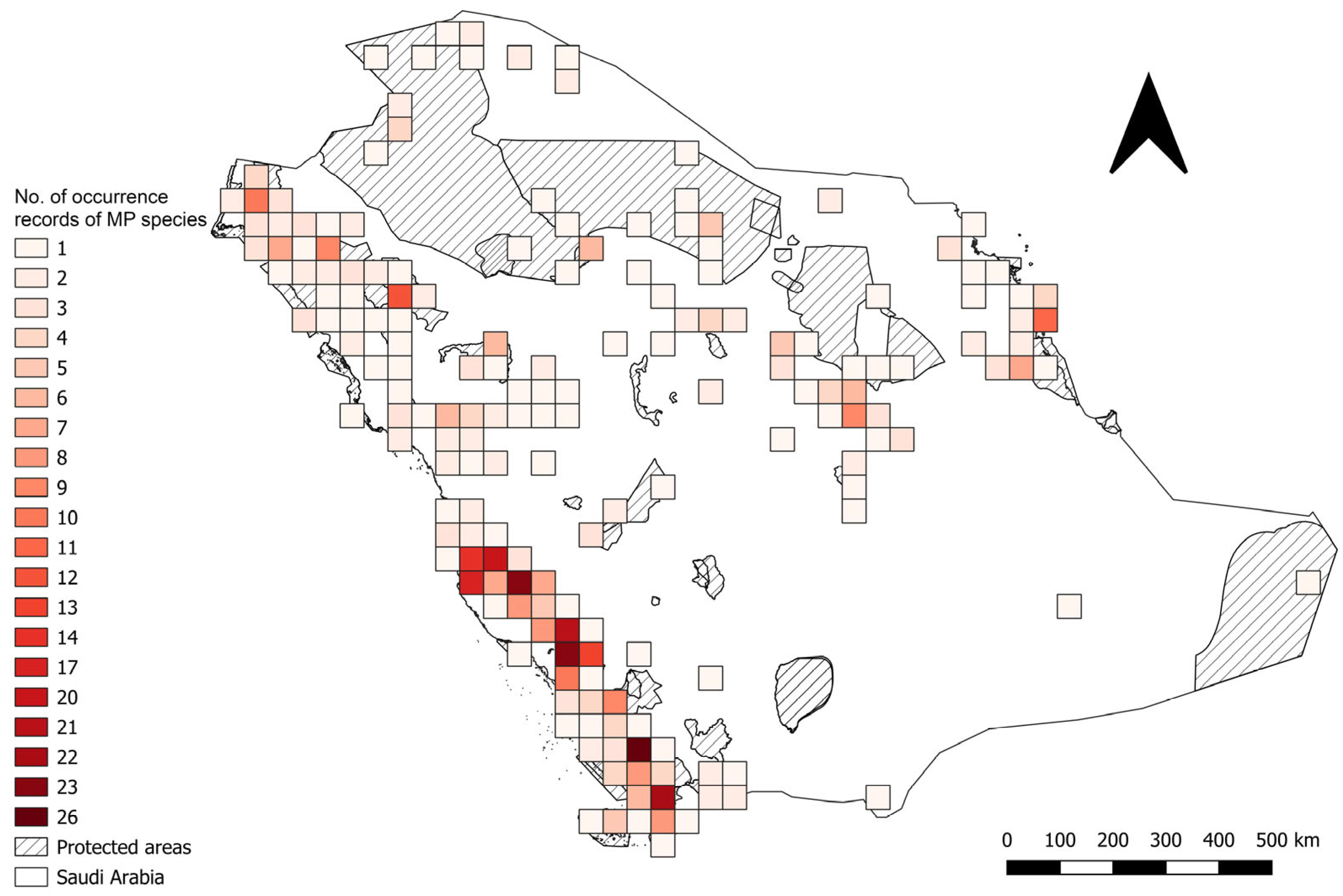
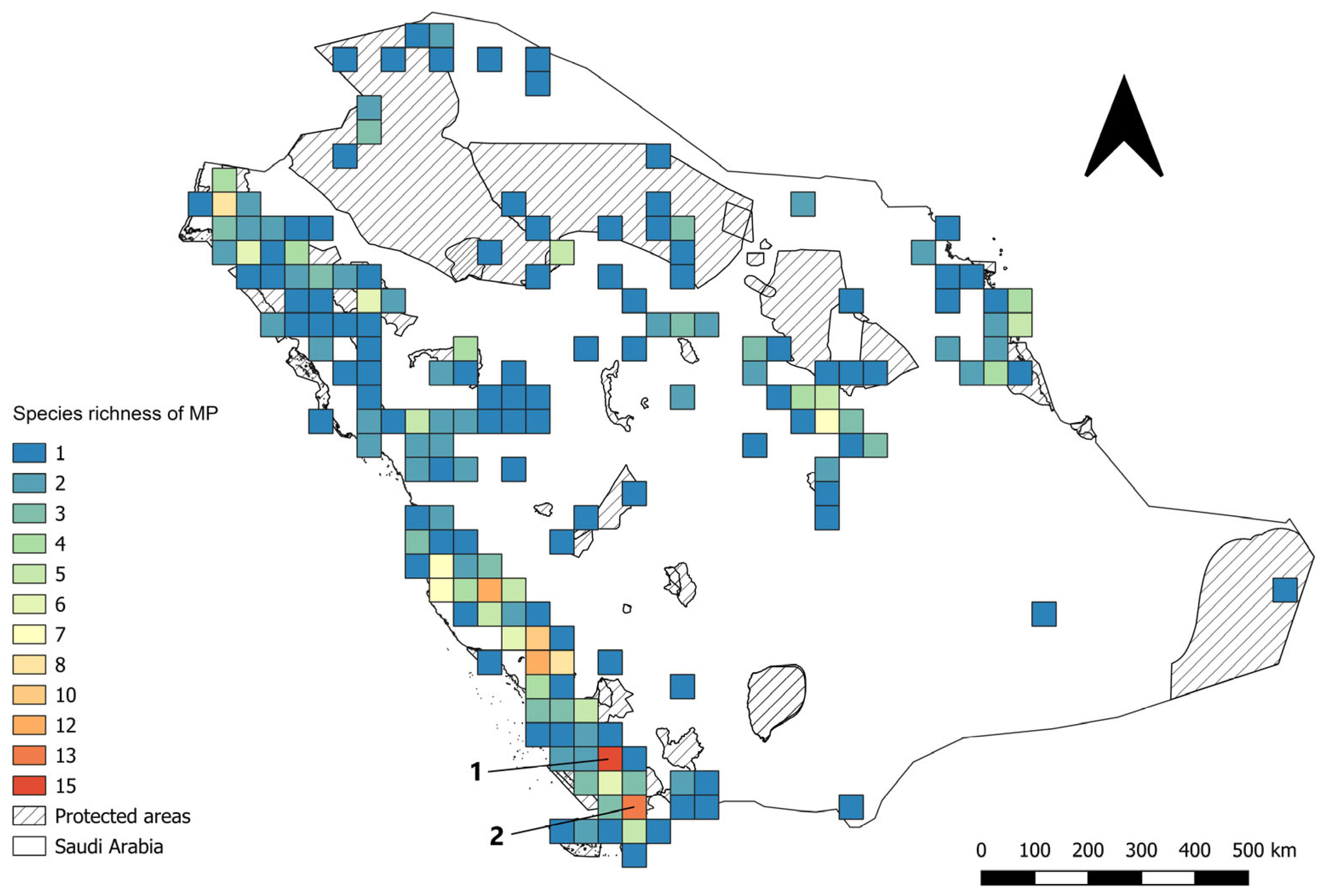
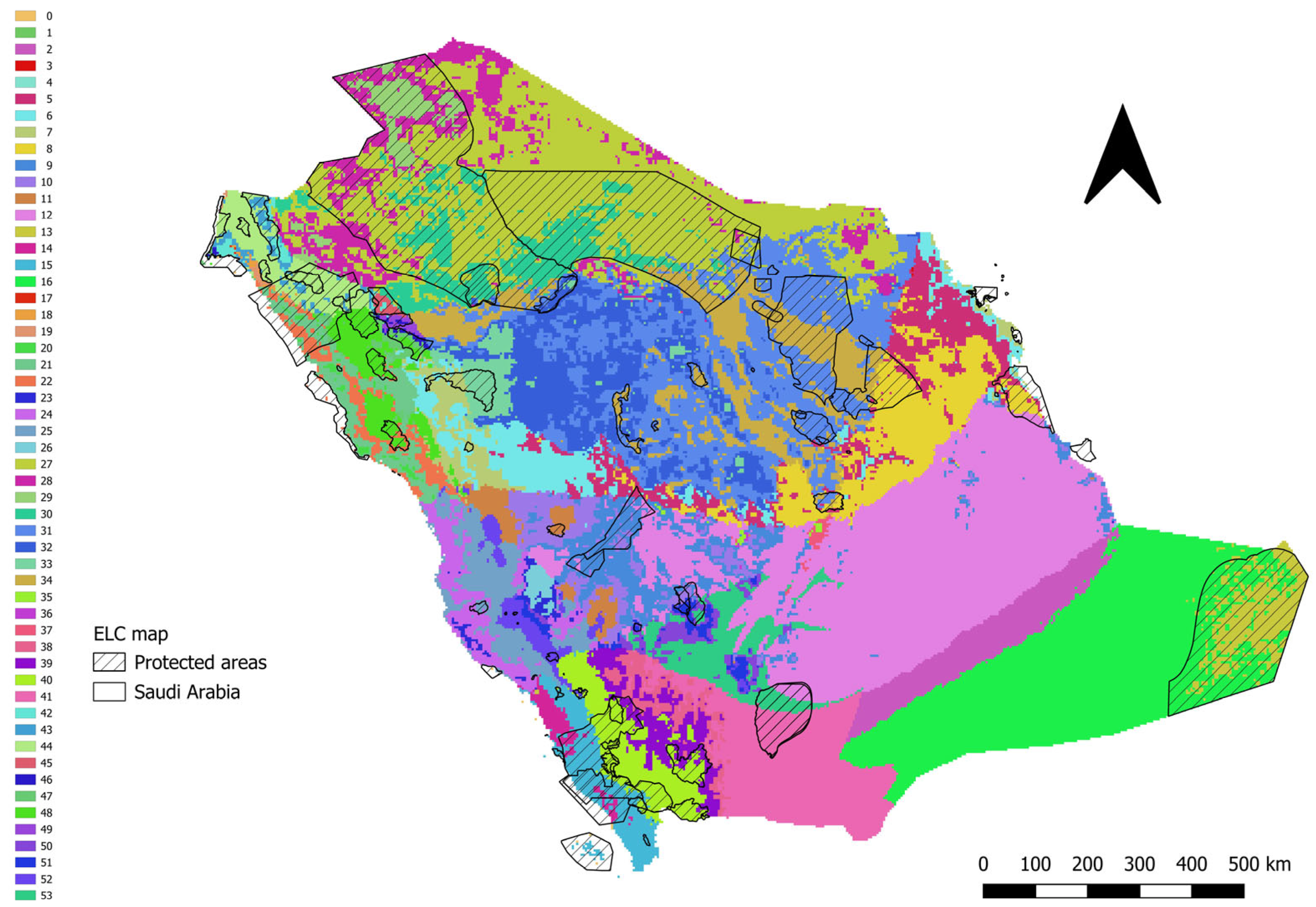
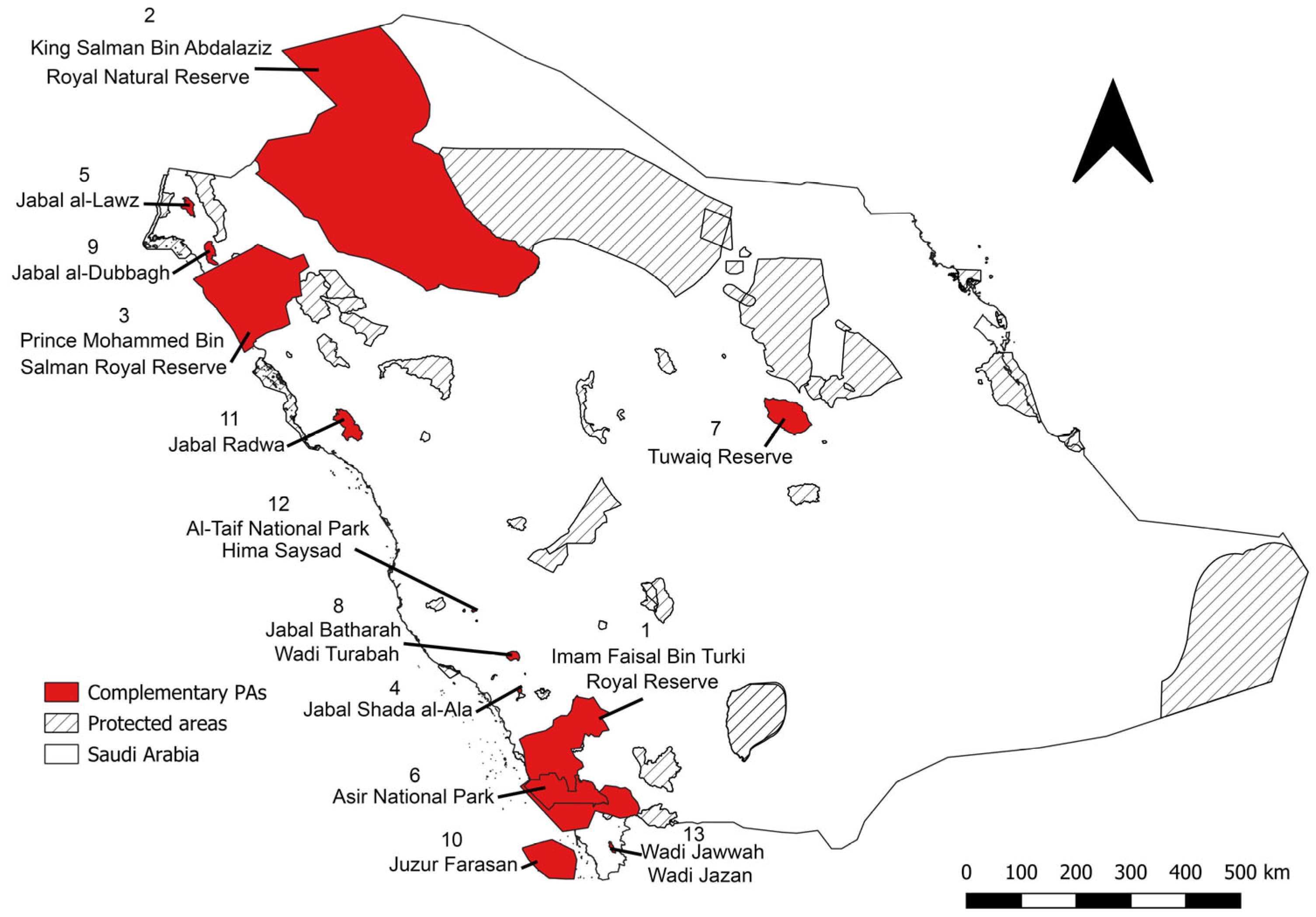
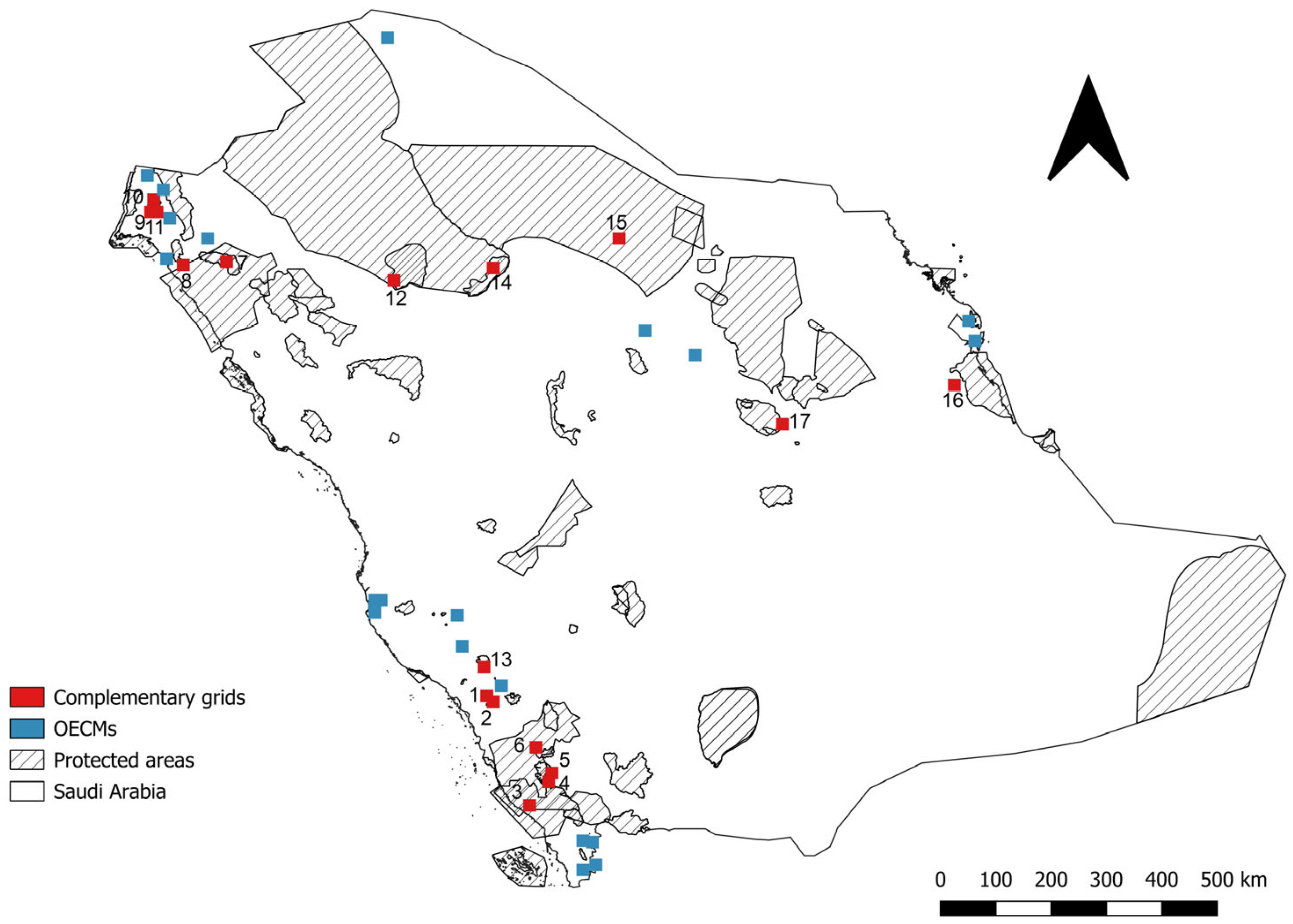
| Rank | Complementary PAs | No. of Observation Records | No. of Unique MPs | Province |
|---|---|---|---|---|
| 1 | Imam Faisal bin Turki Royal Reserve | 133 | 35 | Asir, Jazan, and Makkah |
| 2 | King Salman Bin Abdalaziz Royal Natural Reserve | 25 | 11 | Hail, Tabuk, Al-Jowf, and Northern Borders |
| 3 | Prince Mohammed bin Salman Royal Reserve | 32 | 4 | Tabuk |
| 4 | Jabal Shada al-A‘la | 19 | 3 | Al-Baha |
| 5 | Jabal al-Lawz | 8 | 3 | Tabuk |
| 6 | Asir National Park | 6 | 1 | Asir |
| 7 | Tuwaiq Reserve | 14 | 1 | Riyadh |
| 8 | Jabal Batharah/Wadi Turabah | 10 | 1 | Makkah |
| 9 | Jabal al-Dubbagh | 2 | 1 | Tabuk |
| 10 | Juzur Farasan | 8 | 1 | Jazan |
| 11 | Jabal Radwa | 8 | 1 | Medina |
| 12 | Al-Taif National Park/Hima Saysad | 1 | 1 | Makkah |
| 13 | Wadi Jawwah/Wadi Jazan | 2 | 1 | Jazan |
| Recommendation | Purpose/Outcome |
|---|---|
| 1. Improve cooperation between in situ and ex situ medicinal plant conservation programs and increase government support | Strengthen coordination, funding and community involvement (e.g., citizen science) |
| 2. Ground truth medicinal plant presence in protected areas and develop a national conservation strategy and action plan | Validate species presence and create a strategic framework with threat assessments |
| 3. Expand small protected areas or utilize other effective area-based conservation measures in priority medicinal plant areas | Increase in situ coverage in biodiversity hotspots (e.g., Asir and Jazan) |
| 4. Conduct targeted field surveys for underrepresented medicinal plant species | Ensure representation of medicinal plant species in at least five protected areas as a minimum conservation threshold (Tables S7 and S8) [69] |
| 5. Enhance genebanks: facilities, training and field collection | Improve ex situ resources, genetic monitoring and redundancy (e.g., Svalbard Seed Vault) |
| 6. Apply genomic and biotechnology tools | Support propagation via tissue culture, cryopreservation and genetic conservation |
| 7. Analyse climate change impacts | Anticipate distribution shifts and integrate findings into future conservation planning |
| 8. Employ GIS and remote sensing tools | Support habitat mapping and dynamic monitoring of medicinal plant distributions |
| 9. Strengthen international partnerships and legal frameworks | Increase knowledge exchange, capacity building and regulatory support |
| 10. Review and update conservation priorities | Maintain alignment with latest data and science, emphasizing endemic/traditionally used species |
| 11. Document ethnopharmacological uses of vulnerable medicinal plant species | Integrate traditional knowledge into conservation prioritization and awareness |
| 12. Ensure practical application of recommendations | Translate strategies into national plans, regional actions and local community engagement |
Disclaimer/Publisher’s Note: The statements, opinions and data contained in all publications are solely those of the individual author(s) and contributor(s) and not of MDPI and/or the editor(s). MDPI and/or the editor(s) disclaim responsibility for any injury to people or property resulting from any ideas, methods, instructions or products referred to in the content. |
© 2025 by the authors. Licensee MDPI, Basel, Switzerland. This article is an open access article distributed under the terms and conditions of the Creative Commons Attribution (CC BY) license (https://creativecommons.org/licenses/by/4.0/).
Share and Cite
Alzahrani, I.J.; Magos Brehm, J.; Maxted, N. Gap Analysis of Priority Medicinal Plant Species in the Kingdom of Saudi Arabia. Plants 2025, 14, 2629. https://doi.org/10.3390/plants14172629
Alzahrani IJ, Magos Brehm J, Maxted N. Gap Analysis of Priority Medicinal Plant Species in the Kingdom of Saudi Arabia. Plants. 2025; 14(17):2629. https://doi.org/10.3390/plants14172629
Chicago/Turabian StyleAlzahrani, Ibrahim Jamaan, Joana Magos Brehm, and Nigel Maxted. 2025. "Gap Analysis of Priority Medicinal Plant Species in the Kingdom of Saudi Arabia" Plants 14, no. 17: 2629. https://doi.org/10.3390/plants14172629
APA StyleAlzahrani, I. J., Magos Brehm, J., & Maxted, N. (2025). Gap Analysis of Priority Medicinal Plant Species in the Kingdom of Saudi Arabia. Plants, 14(17), 2629. https://doi.org/10.3390/plants14172629






